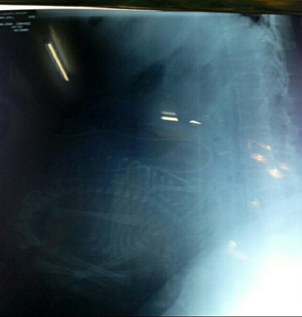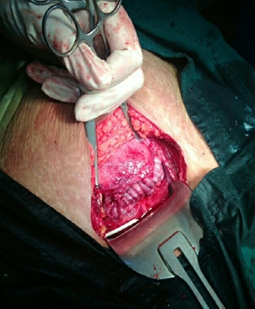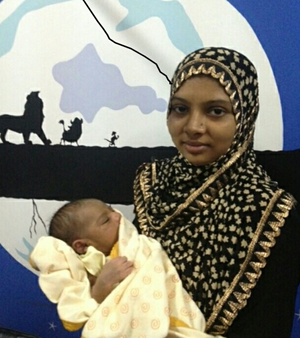Case Report
Volume 1 Issue 1 - 2017
Case Report of Pregnancy and Delivery in a Woman with Cerebrospinal Fluid Shunt Due to Hydrocephalus
Associate Professor, Bangladesh Medical College & Hospital, Dhaka-1209, Bangladesh
*Corresponding Author: Rezina Hamid, Associate Professor, Bangladesh Medical College & Hospital, Dhaka-1209, Bangladesh.
Received: April 08, 2017; Published: June 19, 2017
Abstract
Pregnancy and delivery of a mother with VP shunt is a rare case in our scenario. As treatment facilities and social awareness about the hydrocephalus babies are improved, we hope to get such cases in coming years. In 2010 a girl of 10 years was admitted with post-meningitic hydrocephalus in Bangladesh Medical College & Hospital. We treated her with attempted endoscopic procedure followed by Ventriculo-peritoneal shunt. In late 2015, she was pregnant and was advised to continue follow up by the department of gynecology and obstetrics in same institution. After completion of full term, she gave birth of a baby boy by cesarean section in presence of obstetrician and neurosurgeon. Here the assessment of shunt function and management of the peritoneal end of the shunt tube during cesarean section is highlighted.
Keywords: Ventriculo-peritoneal shunt; Pregnancy; Cesarean section
Abbreviations: VP shunt: Ventriculo-peritoneal shunt; CSF: Cerebrospinal fluid; ETV: Endoscopic third ventriculostomy; CT scan: computed tomography; A-P: Anterior-prosterior; USG: Ultrasonography; APGAR score: Appearance pulse rate, grimace, activity, respiratory effort
Introduction
Hydrocephalus occurs when there is excess production or most commonly decreased absorption of CSF. It may be consequence of aqueductal stenosis, meningitis, intracranial hemorrhage or brain tumor [1]. Now a days with better management and surgical facilities many of the kids are reaching adult life and incorporate themselves in mainstream. There are two approaches to treat Hydrocephalus. The most common treatment is placement of shunt in the form of ventriculo-peritoneal, ventriculo-pleural or ventriculo-arterial shunt [2]. The other procedure is Endoscopic third ventriculostomy (ETV), involves the surgical creation of an opening in the floor of third ventricle to enable the passage of CSF into the cisterns [3].
Pregnancy with VP shunt are reported internationally. In event of late stage of pregnancy and delivery there is rise of intracranial pressure due to high intraabdominal pressure [4]. Apart from usual problem there may be inadvarant injury of peritoneal end of vp shunt during caesarian section. Complications of VP shunt includes shunt infection, shunt blockage or disconnection. Intra-abdominal complications include: intestinal obstruction, gut perforation, pseudocyst formation [5]. Other complications are reported in literature include CSF ascitis, inguinal hernia, and intestinal volvulus [6].
Case Summary
In 2010 a girl of 10 years was admitted with complain of continuous headache specially increased in early morning, occasional vomiting, blurring of vision. She had history of high grade fever, seizure attack, five months prior to this event and treated in hospital. On examination we found a lethargic girl, she had no motor sensory deficit. Fundoscopy revealed bilateral papilldema. Her CT scan revealed moderate hydrocephalus of obstructive pattern. We started for endoscopic third venriculostomy, which was not possible for complete distortion of third ventricular anatomy. So in same sitting, we put a ventriculo-peritoneal shunt. Immediately after surgery she improved. Throughout all these years she was followed up over home visit and phone calls.
In 2010 a girl of 10 years was admitted with complain of continuous headache specially increased in early morning, occasional vomiting, blurring of vision. She had history of high grade fever, seizure attack, five months prior to this event and treated in hospital. On examination we found a lethargic girl, she had no motor sensory deficit. Fundoscopy revealed bilateral papilldema. Her CT scan revealed moderate hydrocephalus of obstructive pattern. We started for endoscopic third venriculostomy, which was not possible for complete distortion of third ventricular anatomy. So in same sitting, we put a ventriculo-peritoneal shunt. Immediately after surgery she improved. Throughout all these years she was followed up over home visit and phone calls.
On early 2015 she was married and in December, 2015 she became pregnant. From the very beginning of pregnancy see was seen by a gynecologist who took necessary steps to ensure safe pregnancy. Scan for fetal anomaly was done. Regular USG were done to evaluate any obstruction of the shunt end by kinkning or pseudocyst formation along with fetal status. She had two episodes of headache in 2nd trimester of pregnancy which responded to mild analgesics. In the 38th week of pregnancy USG finding showed oligohydramnion and fetal distress. Emergency caeserian section was done.
On the event of cesarean section, just prior to putting her on theater table we took a portable x-ray of abdomen (A-P/Lateral) for determining the position of peritoneal end of shunt tube (figure-1). She was given spinal anesthesia using 27 gauge needle for infiltration 0.5% bupivacaine. During incision the abdominal wall, every precaution was taken for not to injure the peritoneal end. A healthy baby weighting 2, 5 kg with APGAR score 10 was delivered. After closure of uterus through cleaning and mopping of abdominal cavity was done. Peritoneal end of shunt tube was checked for free flow of CSF (figure 2). Abdomen was closed as usual. In post operative period she had usual dose of ceftriaxone, Metronidazole and Flucloxacillin. She was discharged in 4th postoperative day in smiling face (Figure 3).
Discussion
Pregnancy with VP shunt is not a common case in Bangladesh and there are not enough articles published internationally on this issue. Presence of VP shunt may cause various problems in pregnancy and delivery [4,7]. However in this case there was no pregnancy or delivery related complications. Littleford JA [8] reported a case concerning pregnant patient with shunt. He concluded both general anesthesia and regional anesthesia has been used with no reports of complications directly related to anesthesia. Here spinal anesthesia was given using 27 gauge needle injecting 0.5% Bupivacaine. No complication such as spinal headache noted. Smaller gauge needle was used to minimize CSF leakage.
Nikolov A., et al. [9]. Made a series of twelve pregnant women with VP shunt. They found that shunts do not affect the pregnancy outcome. Only in one case shunt obstructed six weeks after delivery. Then revision was done. They concluded vaginal delivery in women in shunts can be provided successfully with analgesics medicine those don’t increase intracranial pressure. Obstetrical indications and in cases of increased intracranial pressure, caesarian section is the method of choice. In our present case fetal distress and oligohydroamnion were the Obstetrical indications.
B. Haussler., et al. in a case series of: ‘Pregnancy, Delivery and Post-partum case of ventriculo-peritoneal shunt hydrocephalus’ showed the importance of good collaboration of interdisciplinary team of specialists [10]. Specially close follow up of function of the shunt and position of peritoneal catheter carried major role. USG was done in every a cases to recognize shunt occlusion by kinking, cyst formation etc. To determine the final position of peritoneal catheter USG assisted marking done at the end of pregnancy in case of unexpected emergency cesarean section. In our case routine USG done to check fetal condition and peritoneal end of catheter regularly. Final catheter position was located by X-ray abdomen A/P and lateral view.
Conclusions
Bangladesh is going to have more pregnant women with CSF shunt. It’s an iatrogenic condition resulting from better management of hydrocephalic kids. Obstetrician must be aware of this situation as well as anesthesiologist. A very good departmental collaboration is needed to manage them. The observations made in this article are of immense importance for managing the pregnant women with VP shunts. This article will significantly enhance the knowledge of gynecologist, anesthesiologist and neurosurgeons.
Consent
Written informed consent was obtained from the patient for publication of this case report and accompanying images. A copy of the written consent is available for review by the Editor-in-Chief of this journal.
Written informed consent was obtained from the patient for publication of this case report and accompanying images. A copy of the written consent is available for review by the Editor-in-Chief of this journal.
Competing interest: Authors declare that they have no competing interest.
References
- Benjamin C., et al. “Post infectious hydrocephalus: the most common cause of Hydrocehalus; ifHSB: international federation for hydrocephalus and spinal bifida, Consultative status special category with economic and social council of the United Nations Consultative status, Council of Europe.
- Kandasamy J., et al. “Contemporary management and recent advances in paediatric hydrocephalus”. BMJ 343 (2011): 146-151.
- Yadav YR., et al. “Endoscopic third ventriculostomy”. Journal of Neurosciences in Rural Practice 3.2 (2012): 163-173.
- Shiza S., et al. “Management of pregnancy and delivary of a patient with malfunctioning ventriculoperitoneal shunt”. Journal of Obstetrics and Gynaecology32.1 (2008): 6-9.
- Sells CJ., et al. “Gram-negative CSF shunt associated infections”. Pediatrics 59.4 (1977): 614-618.
- Nfonsam V., et al. “Laparoscopic management of distal ventriculoperitoneal shunt complications”. Surgical Endoscopy 22.8 (2008): 1866-1870.
- Shiza S., et al. “Management of pregnancy and delivary of a patient with malfunctioning ventriculoperitoneal shunt”. Journal of Obstetrics and Gynaecology32.1 (2008): 6-9.
- Littleford JA., et al. “Obstetrical anesthesia for a parturient with a ventriculoperitoneal shunt and third ventriculostomy”. Canadian Journal of Anesthesia/Journal canadien d'anesthésie 46.11 (1999): 1057-1063.
- Nikolov A., et al. “Pregnancy and delivary of a women with cerebrospinal fluid shunt”. Akush Ginekol (Sofiia) 47.2 (2008): 3-10.
- B Haeussler., et al. “Pregnancy, Delivery and Postpartum Care of Women with Ventriculo-Peritoneal Shunted Hydrocephalus: a case series”. The Internet Journal of Gynecology and Obstetrics 12.2 (2009).
Citation:
Rezina Hamid., et al. “Case Report of Pregnancy and Delivery in a Woman with Cerebrospinal Fluid Shunt Due to Hydrocephalus”.
Gynaecology and Perinatology 1.1 (2017): 31-34.
Copyright: © 2017 Rezina Hamid., et al. This is an open-access article distributed under the terms of the Creative Commons Attribution License, which permits unrestricted use, distribution, and reproduction in any medium, provided the original author and source are credited.


































 Scientia Ricerca is licensed and content of this site is available under a Creative Commons Attribution 4.0 International License.
Scientia Ricerca is licensed and content of this site is available under a Creative Commons Attribution 4.0 International License.